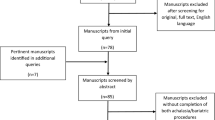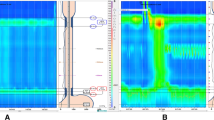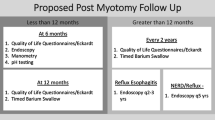Abstract
Background
Achalasia is an esophageal motor disorder that leads to swallowing dysfunction and weight loss. Nutritional risk in achalasia patients is not well defined.
Aims
The aims of this study were to define baseline body mass index (BMI), changes in weight, and nutritional risk over time in a large cohort of achalasia patients.
Methods
This was a retrospective cohort study of achalasia patients at a tertiary care center with documented BMI, symptom severity as per Eckardt score, and nutritional risk assessment as per the Malnutrition Universal Screening Tool, which considers BMI, degree of recent weight loss, and acuity of disease.
Results
Among the 337 patients presenting for achalasia management, 179 had confirmed disease. Upon presentation 69.8% of patients were classified as overweight or obese. Using the Malnutrition Universal Screening Tool, we found 50% of patients to be at moderate or high risk for malnutrition at presentation. Eckardt score (OR 1.15, 95% CI 1.05–1.26), duration of disease (OR for each additional month 1.04, 95% CI 1.01–1.08), and female gender (OR 1.76, 95% CI 1.02–3.03) were independent predictors of increased risk for malnutrition. Nutrition risk score decreased after therapy in 93.3% of patients.
Conclusions
Despite a high prevalence of overweight and obese status in achalasia patients, many are at risk of developing nutritional complications secondary to rapid weight loss. This risk frequently resolves post-treatment. Regardless of baseline BMI, we recommend all patients undergo nutritional assessment to identify high-risk patients who may benefit from dietary intervention and expedited therapy.



Similar content being viewed by others
References
Vaezi MF, Pandolfino JE, Vela MF. ACG clinical guideline: diagnosis and management of Achalasia. Am J Gastroenterol. 2013;108:1238–1249.
Eckardt AJ, Eckardt VF. Treatment and surveillance strategies in achalasia: an update. Nat Rev Gastroenterol Hepatol. 2011;8:311–319.
Lynch KL, Pandolfino JE, Howden CW, Kahrilas PJ. Major complications of pneumatic dilation and Heller myotomy for Achalasia: single-center experience and systematic review of the literature. Am J Gastroenterol. 2012;107:1817–1825.
Gunasingam N, Perczuk A, Talbot M, Kaffes A, Saxena P. Update on therapeutic interventions for the management of achalasia. J Gastroenterol Hepatol. 2016;31:1422–1428.
Kahrilas PJ, Bredenoord AJ, Fox M, et al. The Chicago classification of esophageal motility disorders, v3.0. J Neurogastroenterol Motil. 2015;27:160–174.
Bredenoord AJ, Fox M, Kahrilas PJ, et al. Chicago classification criteria of esophageal motility disorders defined in high resolution esophageal pressure topography. Neurogastroenterol Motil. 2012;24:57–65.
Ulijaszek SJ. Obesity: Preventing and Managing the Global Epidemic. Report of a WHO Consultation. Geneva: World Health Organization; 2000:252. WHO Technical Report Series 894.
Todorovic V, Russell C, Elia M. The ‘MUST’ Explanatory Booklet: A Guide to the ‘Malnutrition Universal Screening Tool’ (‘MUST’) for Adults. Malnutrition Action Group: A Standing Committee of BAPEN; 2003.
Flegal KM, Kruszon-Moran D, Carroll MD, Fryar CD, Ogden CL. Trends in obesity among adults in the United States, 2005–2014. JAMA. 2016;315:2284.
Rakita SS, Villadolid D, Kalipersad C, Thometz D, Rosemurgy A. BMI affects presenting symptoms of Achalasia and outcome after Heller myotomy. Surg Endosc. 2007;21:258–264.
Ross SW, Oommen B, Wormer BA, et al. National outcomes of laparoscopic Heller myotomy: operative complications and risk factors for adverse events. Surg Endosc. 2015;29:3097–3105.
Fisichella PM, Raz D, Palazzo F, Niponmick I, Patti MG. Clinical, radiological, and manometric profile in 145 patients with untreated Achalasia. World J Surg. 2008;32:1974–1979.
Hulselmans M, Vanuytsel T, Degreef T, et al. Long-term outcome of pneumatic dilation in the treatment of Achalasia. Clin Gastroenterol Hepatol. 2010;8:30–35.
Jeon HH, Kim JH, Youn YH, Park H, Conklin JL. Clinical characteristics of patients with untreated Achalasia. J Neurogastroenterol Motil. 2017;23:378–384.
Author information
Authors and Affiliations
Contributions
CN was involved in the study design, data collection, data interpretation, and manuscript preparation. RV was involved in data analysis, interpretation, and content of the manuscript. OP-B was involved in the manuscript preparation. GF was involved in the data interpretation and manuscript preparation. YXY was involved in the data analysis, interpretation, and content of the manuscript. KL was involved in the study design, data interpretation, and manuscript preparation.
Corresponding author
Ethics declarations
Conflict of interest
The authors declare that they have no conflict of interest.
Ethical approval
All procedures performed in studies involving human participants were in accordance with the ethical standards of the institutional and/or national research committee and with the 1964 Declaration of Helsinki and its later amendments or comparable ethical standards. For this type of study, formal consent is not required.
Rights and permissions
About this article
Cite this article
Newberry, C., Vajravelu, R.K., Pickett-Blakely, O. et al. Achalasia Patients Are at Nutritional Risk Regardless of Presenting Weight Category. Dig Dis Sci 63, 1243–1249 (2018). https://doi.org/10.1007/s10620-018-4985-8
Received:
Accepted:
Published:
Issue Date:
DOI: https://doi.org/10.1007/s10620-018-4985-8




